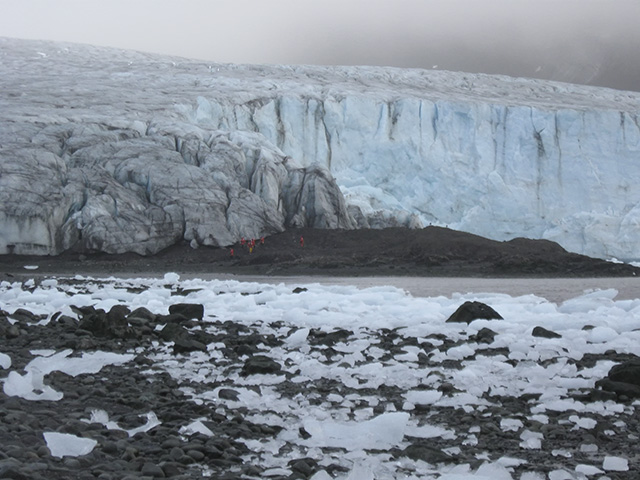Islands are evolutionary cradle for Antarctica marine life
For immediate release ‐ July 28, 2017
Contact: Jon Pishney, 919.707.8083. Images available upon request

Members of the research team approach Ecology Glacier on Livingston Island. Photo: Jon Moore
RALEIGH, N.C. — The largely barren islands reaching north from Antarctica are actually the birthplace of many modern species of marine life — and perhaps will be the first place impacted by invading species that accompany climate change, according to a study by researchers at the North Carolina Museum of Natural Sciences and Yale University.
For millions of years, the Antarctic has been insulated from other ecosystems by a cold water thermal barrier. As a result, one lineage of fish adapted to cold water has come to dominate the entire continental region. Almost all species of fish in Antarctica are from the notothenioid family, which includes the restaurant staple Chilean sea bass.
A genetic analysis conducted by researchers from the N.C. Museum of Natural Sciences and the Peabody Museum at Yale shows that during periodic advances of glacial ice many species of marine life retreated to the Scotia Arc, the archipelago that extends northward into the Southern Ocean. It is there that new species arose and, as ice retreated again, repopulated areas of the continent.
“Imagine if Florida and the Bahamas were the places that repeatedly gave rise to North America’s animal species,” says Alex Dornburg, research curator of ichthyology at the N.C. Museum of Natural Sciences and lead author of the study. “It would put an entirely different emphasis on our conservation efforts and resource management strategies.”
Much like Florida, the Antarctic northern peninsula is now threatened with the arrival of new species that have the potential to fundamentally alter the food web of this fragile marine ecosystem, the authors say. Also, the fishes of the Southern Ocean are the basis of a multi-billion-dollar international economy and a major source of food for whales, seals, penguins and albatrosses.
“We used to think diversity was generated on continents and spread to islands,” said Thomas Near, associate professor of ecology and evolutionary biology and senior author of the paper appearing in the journal Nature Ecology and Evolution in July. “But in Antarctica, it is the islands that hold seeds of diversity and the continent which is home to the youngest species.”
“In a strangely elegant twist of fate, the source area for Antarctica’s marine fish species is now a point of entry for new species,” says Dornburg. “We may be seeing the reversal of a major evolutionary process.”
This ancient pattern found by the team is already threatened by climate change and arrival in the Scotia Arc of invasive species such as king crabs, a predator that promises to disrupt the delicate balance of marine life.
“The system is very fragile and marine life have had only limited predators to deal with,” Near adds. “Now it’s an all-you-can-eat buffet.”
Primary funding for the research was provided by the National Science Foundation.
Other authors of the paper — “Cradles and museums of Antarctic teleost biodiversity” — included Sarah Federman of Yale University, April Lamb of North Carolina State University and the N.C. Museum of Natural Sciences, and Christopher Jones of National Oceanic and Atmospheric Administration.

